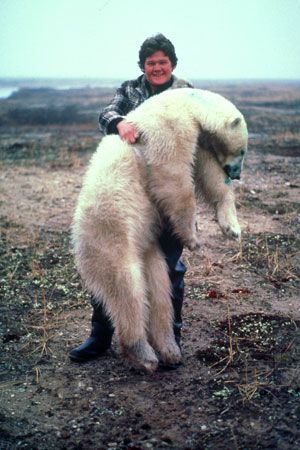by Ian Thorleifson

Ian carrying tranquilized polar bear near Hudson Bay
We’ve all heard many sad stories and dire predictions about the future of the polar bears of Western Hudson Bay. And they have had some tough years – particularly in the early 2000s. The worst year they ever had was not recent however, it was almost 30 years ago. In 1983
My knowledge of 1983 is first hand. I was in charge of the Polar Bear Alert Program that year, and I was working as a biologist for Manitoba Wildlife Branch, and with the very capable crew from Ian Stirling’s group of the Canadian Wildlife Service.
But I must qualify that my observations are not backed by rigorous science – we simply did not have that defensible level of knowledge then. We did have a substantial amount of observations, notes and perceptions built up from many people’s observations over many years.
By 1983 the Canadian Wildlife Service had been intently working with the polar bears in Hudson Bay for about 15 years. A large percentage of the bears in the population were tagged – at least half of them, maybe three quarters. We estimated that there were about 1800 bears in the South Western Hudson Bay (SWHB) polar bear population at the time.
Productivity was very good – most mother bears had two cubs with them and many of those cubs were “independent yearlings” – able to hunt and care for themselves, and to allow their mothers to re-breed every two years – the most productive polar bear population known at the time.
Tourism, especially that related to polar bear watching, was starting to roll in Churchill – Dan Guravich and Len Smith and their Cape Churchill crew had been to the Cape for up to three weeks at a time for four years now – and their observations and photos had identified a “rogue’s gallery” of big old male bears who were at the Cape every year.
The winter of 1982-83 saw very heavy snowfall accumulating in SWHB, so heavy one could imagine the bears having a challenge getting through to the seals. When the bears were forced ashore, they were in “ok” condition, but not really fat. But they were early – by the first two weeks of July the ice had broken up and quickly melted completely out of the Bay. Then the summer was HOT. And DRY. We worked on the tundra with no shirts on – and no mosquitoes! The heat stressed the bears even more than the mosquitoes would have.
By November, there were a lot of bears around – and far too many were getting very skinny. In the middle of November, very cold weather brought a quick freeze – and bears started moving out onto the ice. Then came the big south wind with melting temperatures and weeks of fog and mist. The ice was completely melted, and the number of bears along the Coast was amazing – I counted 50 different bears in a 14-mile drive! Eight bears were shot by local people in self-defense. On November 29, a man was killed on the main street of Churchill by a young male bear. The Polar Bear Alert crew was handling as many as 15 bears a day. Walking skeletons were seen too often. And still no freeze-up until almost mid-December.
We did not realize the impact this all had on the population until a couple of years had gone by. At Cape Churchill, Dan could recognize only a couple of the “rogues” they had previously seen. And 1984 saw the lowest number of bear incidents in the history of the Alert Program.
Based on these observations and the “Mark/Recapture” rate of the next few years, we estimated that HALF of the SWHB population perished out on the ice that winter. We find very few dead bears, because they do not die where we can find them. Travel out on the Bay is very difficult and dangerous.
The population built up again in the late ‘80s and ‘90s – to at least 1200 to 1400 bears, then declined to the 950 or so estimated today. But no one year was ever as bad as 1983…the Worst Year Ever for polar bears.








